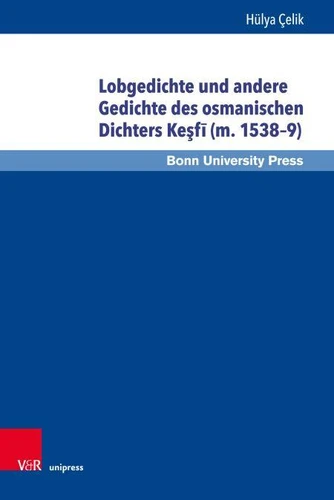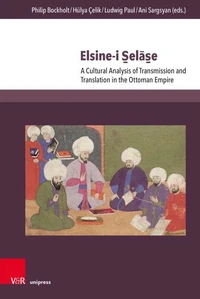Lobgedichte und andere Gedichte des osmanischen Dichters Keşfī (m. 1538–9). Versuch der Bestimmung eines unpopulären Stils
Par :Formats :
Disponible dans votre compte client Decitre ou Furet du Nord dès validation de votre commande. Le format PDF est :
- Compatible avec une lecture sur My Vivlio (smartphone, tablette, ordinateur)
- Compatible avec une lecture sur liseuses Vivlio
- Pour les liseuses autres que Vivlio, vous devez utiliser le logiciel Adobe Digital Edition. Non compatible avec la lecture sur les liseuses Kindle, Remarkable et Sony
 , qui est-ce ?
, qui est-ce ?Notre partenaire de plateforme de lecture numérique où vous retrouverez l'ensemble de vos ebooks gratuitement
Pour en savoir plus sur nos ebooks, consultez notre aide en ligne ici
- Nombre de pages402
- FormatPDF
- ISBN978-3-8470-0986-3
- EAN9783847009863
- Date de parution12/08/2019
- Protection num.pas de protection
- Taille3 Mo
- Infos supplémentairespdf
- ÉditeurV&R Unipress
Résumé
Hulya Celik untersucht das Leben und einen Teil des Werkes des osmanischen Dichters Kesfi (gest. 1538-9) mithilfe von Informationen aus Dichterbiographien, den Werken des Dichters selbst, Archivdokumenten und anderen Primarquellen des 16. Jahrhunderts. Ein wichtiger Teil ihrer Arbeit widmet sich der Dichtung Kesfis und bearbeitet insgesamt 105 Gedichte. Dabei handelt es sich zum Großteil um Lobgedichte (Qasiden), aber auch um Strophengedichte und Chronogramme, die sich in der einzigen bisher bekannten Handschrift der Gedichtsammlung Kesfis befinden.
Dieser Band beinhaltet eine Edition der Gedichte und geht tiefgehend auf deren technische Eigenschaften, Sprache und Stil ein. Hinsichtlich des Stils der Gedichte untersucht die Autorin die rhetorischen Elemente und veranschaulicht diese mit Gedichtpassagen. Hulya Celik investigates the life and work of the Ottoman poet Kesfi (d. 1538-9), focusing on the poet's origin, writing career, social life and literary milieu.
A large part of the book is devoted to Kesfi's poetry and comprises a study of 105 poems in total, mainly eulogies (qasides) but also a few strophic poems and chronograms. In order to adequately address the question of Kesfi's poetic talent (that his contemporaries doubted he possessed), Kesfi's eulogies are compared with those of some prominent Ottoman poets of his time, who are regarded as 'masters' by modern literary critics.
The book shows that studying little known poets may open up new venues for the evaluation of the esthetic quality of Ottoman poetry that does not take center stage.
Dieser Band beinhaltet eine Edition der Gedichte und geht tiefgehend auf deren technische Eigenschaften, Sprache und Stil ein. Hinsichtlich des Stils der Gedichte untersucht die Autorin die rhetorischen Elemente und veranschaulicht diese mit Gedichtpassagen. Hulya Celik investigates the life and work of the Ottoman poet Kesfi (d. 1538-9), focusing on the poet's origin, writing career, social life and literary milieu.
A large part of the book is devoted to Kesfi's poetry and comprises a study of 105 poems in total, mainly eulogies (qasides) but also a few strophic poems and chronograms. In order to adequately address the question of Kesfi's poetic talent (that his contemporaries doubted he possessed), Kesfi's eulogies are compared with those of some prominent Ottoman poets of his time, who are regarded as 'masters' by modern literary critics.
The book shows that studying little known poets may open up new venues for the evaluation of the esthetic quality of Ottoman poetry that does not take center stage.
Hulya Celik untersucht das Leben und einen Teil des Werkes des osmanischen Dichters Kesfi (gest. 1538-9) mithilfe von Informationen aus Dichterbiographien, den Werken des Dichters selbst, Archivdokumenten und anderen Primarquellen des 16. Jahrhunderts. Ein wichtiger Teil ihrer Arbeit widmet sich der Dichtung Kesfis und bearbeitet insgesamt 105 Gedichte. Dabei handelt es sich zum Großteil um Lobgedichte (Qasiden), aber auch um Strophengedichte und Chronogramme, die sich in der einzigen bisher bekannten Handschrift der Gedichtsammlung Kesfis befinden.
Dieser Band beinhaltet eine Edition der Gedichte und geht tiefgehend auf deren technische Eigenschaften, Sprache und Stil ein. Hinsichtlich des Stils der Gedichte untersucht die Autorin die rhetorischen Elemente und veranschaulicht diese mit Gedichtpassagen. Hulya Celik investigates the life and work of the Ottoman poet Kesfi (d. 1538-9), focusing on the poet's origin, writing career, social life and literary milieu.
A large part of the book is devoted to Kesfi's poetry and comprises a study of 105 poems in total, mainly eulogies (qasides) but also a few strophic poems and chronograms. In order to adequately address the question of Kesfi's poetic talent (that his contemporaries doubted he possessed), Kesfi's eulogies are compared with those of some prominent Ottoman poets of his time, who are regarded as 'masters' by modern literary critics.
The book shows that studying little known poets may open up new venues for the evaluation of the esthetic quality of Ottoman poetry that does not take center stage.
Dieser Band beinhaltet eine Edition der Gedichte und geht tiefgehend auf deren technische Eigenschaften, Sprache und Stil ein. Hinsichtlich des Stils der Gedichte untersucht die Autorin die rhetorischen Elemente und veranschaulicht diese mit Gedichtpassagen. Hulya Celik investigates the life and work of the Ottoman poet Kesfi (d. 1538-9), focusing on the poet's origin, writing career, social life and literary milieu.
A large part of the book is devoted to Kesfi's poetry and comprises a study of 105 poems in total, mainly eulogies (qasides) but also a few strophic poems and chronograms. In order to adequately address the question of Kesfi's poetic talent (that his contemporaries doubted he possessed), Kesfi's eulogies are compared with those of some prominent Ottoman poets of his time, who are regarded as 'masters' by modern literary critics.
The book shows that studying little known poets may open up new venues for the evaluation of the esthetic quality of Ottoman poetry that does not take center stage.




